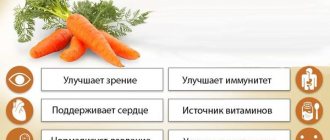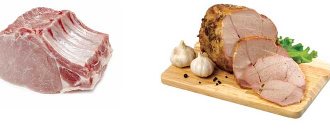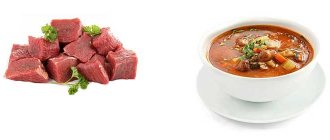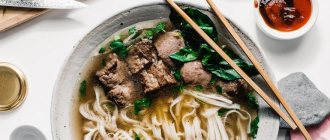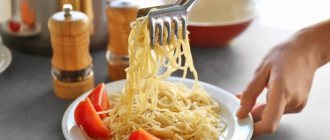BJU and calorie content of chicken per 100 grams: boiled, fried, fillet, thighs
| Chicken | Calorie content, kcal | Proteins, grams | Fats, grams | Carbohydrates, grams |
| Boiled | 170 | 24 | 7,4 | 0,6 |
| Fried | 245 | 26 | 13 | 0,4 |
| Fillet | 113 | 23 | 2,7 | 0,55 |
| Hip | 160 | 20 | 9 | 1,5 |
https://youtu.be/https
://www.youtube.com/watch?v=1M3my4JuDBg
Vitamins
Of the fat-soluble vitamins, boiled or stewed chicken contains A, D, D3, E and K. Of the water-soluble vitamins, there are vitamins B1, B2, B3 (PP), B4, B5, B6, B9 and B12.
>»> >»> >»> >»> >»> >»> >»> >»> >»> >»> >»> >»> >»> >»> >»> >»> >»>
| Vitamins, content | Share of daily value per 100 g | |
| Vitamin A | 15.0 mcg | 1,7% |
| Beta carotene | 0.0 µg | 0,0% |
| Alpha carotene | 0.0 µg | 0,0% |
| Vitamin D | 0.1 mcg | 0,7% |
| Vitamin D2 | n/a | 0,0% |
| Vitamin D3 | 0.1 mcg | 0,6% |
| Vitamin E | 0.3 mg | 1,8% |
| Vitamin K | 2.4 mcg | 2,0% |
| Vitamin C | 0.0 mg | 0,0% |
| Vitamin B1 | 0.0 mg | 4,1% |
| Vitamin B2 | 0.2 mg | 12,5% |
| Vitamin B3 | 6.1 mg | 38,2% |
| Vitamin B4 | 72.4 mg | 14,5% |
| Vitamin B5 | 0.7 mg | 14,9% |
| Vitamin B6 | 0.3 mg | 20,0% |
| Vitamin B9 | 6.0 mcg | 1,5% |
| Vitamin B12 | 0.2 mcg | 9,2% |
How many calories are in chicken and chicken by-products of different cooking methods?
Chicken soup, chicken stew, chicken breast on a salad - chicken in almost any form is very healthy. Chicken is a lean and low-calorie protein food, making it ideal for weight maintenance. Not to mention, this bird is chock full of essential nutrients and vitamins. But how many calories are in chicken?
It all depends on:
- what part of the chicken was cooked;
- how it is prepared;
- how she was prepared.
Different parts of chicken have different levels of fat and cholesterol. When counting the calories in a chicken dish, it's important to consider these factors because there will ultimately be a big difference between one chicken leg and one half chicken breast, or between a fried breast and a grilled one.
Chicken can be called a healthy or unhealthy food depending on how it is prepared. Probably the most famous way to cook chicken is chicken soup, which is especially useful for colds. Fried chicken is clearly not healthy, but boiled chicken is not only tasty, but also healthy. Additionally, the freshness of the chicken also influences the health benefits. Frozen chicken is not healthy because it contains preservatives. But fresh chicken is packed with healthy proteins.
If you are concerned about the number of calories you consume in chicken dishes, remove the chicken skin before eating as it contains a lot of fat.
| How many calories are in whole chicken? | ||
| Chicken product/chicken dish | Calorie content, kcal per 100 grams | Calorie content, kcal per 1 piece. |
| Domestic chicken carcass | 195,09 | 2926 |
| Broiler carcass | 219 | 6570 |
| Chicken carcass | 201,07 | 1053,5 |
| How many calories are in different parts of chicken? | ||
| Chicken product/chicken dish | Calorie content, kcal per 100 grams | |
| Shin (leg) | 177,77 | |
| Quarter (ham) | 181,73 | |
| Hip | 181,28 | |
| Carbonate | 190 | |
| Fillet | 124,20 | |
| Breast | 115,77 | |
| Necks | 166,55 | |
| Wings (wings) | 198,51 | |
| Paws | 130 | |
| Backrests | 319 | |
| How many calories are in chicken by-products? | ||
| Chicken product/chicken dish | Calorie content, kcal per 100 grams | |
| Liver | 142,75 | |
| Hearts (hearts) | 160,33 | |
| Navels | 114,76 | |
| Stomachs (ventricles) | 127,35 | |
| Leather | 206,80 | |
| How many calories are in chicken in different cooking methods? | ||
| Chicken product/chicken dish | Calorie content, kcal per 100 grams | |
| Raw | 191,09 | |
| Boiled | 166,83 | |
| Boiled breast without skin | 241 | |
| Fried | 228,75 | |
| Stewed | 169,83 | |
| Smoked | 184 | |
| Grill | 183,78 | |
| Baked in the oven | 244,66 | |
| White meat chicken broth | 15 | |
| Ground meat | 143 | |
Chicken breast boiled, fried, baked
The method of preparing food largely determines the energy value of the finished dish. Those who adhere to a healthy diet should boil skinless and boneless chicken breast. In this case, its calorie content reaches 137 kcal; such meat goes well with both cereals and vegetables.
Steamed breast has a minimum calorie content of 113 kcal.
It is not recommended to fry fillet, because chicken often turns out to be dry, and the energy value of the prepared dish increases sharply (~ 158 kcal). The calorie content of fried breast depends on the amount of vegetable oil used during cooking. It is recommended to grill the fillet; it contains fewer calories (~ 150 kcal).
A dietary option for preparing chicken is baking it in the oven. The meat can be marinated in spices and seasonings, add soy sauce and orange juice. Thanks to this, it will be soft and juicy, and the finished dish will become the main component of dinner. But it should be noted that additional ingredients increase the nutritional value of cooked meat.
Composition and beneficial properties of chicken fillet
Nutritional value of 100 g chicken:
- saturated fat (4 g);
- cholesterol (75 mg);
- calcium (11 mg);
- iron (0.9 mg);
- magnesium (20 mg);
- phosphorus (147 mg);
- potassium (189 mg);
- sodium (70 mg);
- zinc (1.3 mg).
Regarding vitamins:
- vitamin C;
- thiamine;
- riboflavin;
- niacin;
- vitamin B6;
- folate;
- vitamin B12;
- vitamin A;
- vitamin E;
- vitamin D;
- vitamin K.
Chickens raised in cramped and unhygienic farm conditions can be harmful, but if raised by a conscientious owner, the birds are healthy for the following reasons:
- Protein. An excellent low-fat source of protein that promotes muscle growth and development. Helps maintain a healthy body weight and promotes weight loss.
- Benefits for the heart. Eating chicken breast regulates the level of amino acids in the body; if it is too high, it can lead to heart disease.
- Phosphorus. The product is rich in phosphorus, an essential mineral that supports healthy teeth, bones, kidney function, liver, and nervous system.
- Abundant selenium content. This mineral, involved in metabolic processes, is important for the functioning of the thyroid gland, hormones, metabolism and immunity.
- Accelerated metabolism. The B-complex vitamins in chicken support healthy blood vessels, a high metabolic rate, and help burn calories, which helps maintain a healthy weight.
- Niacin. Another B vitamin, it helps protect against cancer and other forms of genetic (DNA) damage.
- Natural antidepressant. Eating domestic chicken will increase the level of serotonin in the brain, improve your mood, and relieve stress.
- Vision. Source of retinol, alpha and beta carotene and lycopene (all derived from vitamin A), are important for healthy vision.
- Healthy skin. Riboflavin (vitamin B2), found in chicken liver, reduces skin problems and restores dry, damaged skin.
- Strengthening bones. Thanks to the protein, eating chicken will help combat bone loss in old age and prevent osteoporosis or arthritis.
Composition and nutritional value of chicken
No type of meat contains as many important substances for the human body as chicken. It contains calcium, magnesium, phosphorus, potassium, iron, as well as valuable vitamins A, B1, B2, B2, B3, B5, B6, B9, C, E and a number of amino acids. But the most important thing is that it is a source of easily digestible protein, which activates the growth of muscle mass.
Useful properties of chicken meat:
- activation of muscle growth;
- strengthening nails and hair;
- acceleration of metabolic processes in the body;
- positive effect on the functioning of the reproductive organs;
- normalization of the nervous system, reduction of stress and anxiety levels;
- maintaining normal blood pressure.
Damage to chicken meat
- Chickens raised for meat on farms are often unhealthy. Unnaturally fast growth from special drugs, combined with being kept in overcrowded cages, means they suffer from a variety of problems. Including lameness, breathing problems, heart problems, chemical burns on the body, infections and, of course, death. It is not uncommon to see dead and dying birds on a poultry farm.
- Chicken carcasses are washed with chlorine to combat bacteria - E. coli and salmonella, which can harm humans. But even chlorine cannot get rid of all bacteria on a carcass.
- Free-range chicken sounds better, but the standards for this definition may not be as good. Even in the “best” free-range systems, the chickens tend to be genetically identical and grow at an unnatural rate. Therefore, meat is no less harmful. Additionally, birds must be "fully feathered" before they have access to the outdoors at 3 weeks of age. But since they will be killed between 4 and 6 weeks of age, "free range" chickens may only have access to freedom for 1 to 2 weeks of their lives.
Mineral composition
The ratio of mineral substances (macro- and microelements) contained in boiled or stewed chicken is presented in the table using diagrams.
>»> >»> >»> >»> >»> >»> >»> >»> >»> >»> >»>
| Minerals, content | Share of daily value per 100 g | |
| Calcium | 14.0 mg | 1,4% |
| Iron | 1.2 mg | 11,7% |
| Magnesium | 21.0 mg | 5,3% |
| Phosphorus | 150.0 mg | 21,4% |
| Potassium | 180.0 mg | 3,8% |
| Sodium | 70.0 mg | 5,4% |
| Zinc | 2.0 mg | 18,1% |
| Copper | 0.1 mg | 6,8% |
| Manganese | 0.0 mg | 0,8% |
| Selenium | 20.9 mcg | 38,0% |
| Fluorine | n/a | 0,0% |
The use of chicken meat in weight loss
White meat is always included in a healthy diet because it is lean and low in fat. Grilled skinless breast is included in any diet due to its low calorie content and protein content. Protein makes you feel full from fewer calories and helps you burn extra calories.
Increasing the amount of protein in the diet reduces total body fat and abdominal fat, but helps increase muscle mass and energy expenditure of the body during weight loss.
The amount of protein-rich foods, including chicken breast, that you need to eat for weight loss depends on individual needs:
- 90 g of protein products daily when consuming 1200 kcal/day;
- 120 g when following a 1400 kcal/day nutrition plan;
- 150 g of protein food when consuming 1600 kcal/day.
The Institute of Medicine considers it safe for adults to get up to 35% of their calories from protein, which amounts to:
- 105 g protein per 1200 kcal/day;
- 122.5 g per 1400 kcal/day;
- 140 g protein for 1600 kcal/day.
Tips for people who want to lose weight:
- choose lean cuts of meat;
- trim as much fat as possible before cooking and discard rendered fat after cooking;
- use healthier cooking methods: bake, stew, steam;
- Minimize the consumption of processed meat: sausages, ham, frankfurters.
Diet recipe
Salad with chicken, avocado and dried cranberries
For refueling:
- 1/4 tbsp. flour;
- salt;
- 1 tsp. dry mustard;
- 2 egg yolks;
- 1/2 cup milk;
- 1/3 cup vinegar (white or apple cider vinegar);
- 1 tbsp. l. olive oil.
For the salad:
- 1 chicken breast, cooked, cooled, diced;
- 1 cup dried cranberries, soaked overnight in water, drained;
- 1/2 tbsp. finely chopped celery;
- ground white pepper;
- chopped parsley;
- 4 or 5 avocados (1/2 avocado per person).
Mix flour, salt and mustard in a saucepan and place on the stove. Separately, beat the egg yolks with milk and vinegar. Slowly pour the mixture into the pan with the dry ingredients and whisk to combine. Cook over medium heat until mixture thickens, remove from heat. Add oil and stir. Cool to room temperature before use.
Place chicken, dried cranberries, celery, salt, pepper, and chopped parsley in a large bowl. Pour over the dressing and stir. Peel the avocado and chop. Place on top of the salad.
Summarize
- Chicken is rich in many important nutrients that can benefit your health.
- However, it is important to choose healthy methods of preparing chicken such as boiling, braising, baking, grilling or steaming over frying.
- Finally, be sure to include chicken in a balanced diet along with plenty of other healthy, protein-rich foods.
Tags: Chicken
About the author: Alexander Fedorov
Candidate of Biological Sciences, biologist, nutrition expert. Graduated from Stavropol State University with a degree in Biology at the Faculty of Biology and Chemistry.
- Related Posts
- Is fish meat? Everything you need to know
- Is canned tuna healthy? Nutritional value, benefits and harms
- Mackerel: benefits and harm to the body
« Previous entry
Chicken fillet - use in diets
Chicken fillet is one of the lowest calorie meats. However, it contains a huge amount of vitamins and minerals, which is important for those who are on a diet and constantly limit themselves. The most beneficial for a healthy diet is skinless chicken breast, steamed or boiled. Read about it in our publication.
By selecting different ingredients with which to cook meat, you can create real culinary masterpieces every day. And monitoring the nutritional value of ready-made meals will allow you to gradually say goodbye to extra pounds.
